Microsoft Flight Simulator: The Good, The Bad And The Ugly
Microsoft Flight Simulator has released a new version, Microsoft Flight Simulator 2020, fourteen years after the release of Microsoft Flight Simulator X. The timing couldn’t be better, of course, with millions of people around the world unable to travel and desperate to feel that they can see the world.
The original flight simulator took form in 1975 when Bruce Artwick, a software engineer and pilot who was doing a Master’s degree in Electrical Engineering, created 3-D graphics for flight simulation on a PDP 11 as a part of his thesis.
After he graduated, he wrote a program for 6800-based machines to prove that the processor was capable of dynamic 3-D graphics along with a series of articles explaining what he’d done.
A magazine editor contacted Artwick to ask if the program was for sale, explaining that readers were writing in, eager to buy it.
Quick to spot an opportunity, Artwick created a software house and started selling the software by mail, originally releasing versions for the 8080, the Altair 8800, the IMSAI 8080. Within a few years he followed up with a version for the Apple II (and the TRS-80) and, before long, Flight Simulator became the most popular software for Apple.
Artwick’s big break featured in the newsletter from Artwick’s Alma Mater: Department of Computer Science University of Illinois at Urbana-Champaign Alumni News: Spring 1996
Artwick then got a call from Microsoft. Microsoft was working with another company that was coming out with a new computer that they predicted would revolutionize the industry, and they wanted to put [Flight Simulator] on it to show off the machine’s graphic capabilities. At the same time, Artwick received a similar call from IBM. He opted to work with Microsoft and the new, revolutionary computer turned out to be the IBM PC.
Microsoft Flight Simulator 1 quickly became a bestseller for Microsoft, with Flight Simulator 2 (1984), Flight Simulator 3 (1988) and Flight Simulator 4 (1989) quickly following it its footsteps, leading people to buy new computers simply to be able to run the simulator.
By today’s standards, it doesn’t use a lot of processing power. In fact, you can play all four of these early versions of Microsoft Flight Simulator for free in your web browser, using the awesome emulator developed by Sebastian Macke and released on github.
Click here to play: https://s-macke.github.io/FSHistory/
In 1999, Microsoft Flight Simulator claimed 21 million copies sold: a Guinness world record. Today, the simulator still holds a record for longest-running videogame series.
Artwick’s last version of Microsoft Flight Simulator was FS for Windows 95 (effectively Flight Simulator 6.0), at which point he sold his company to Microsoft, saying that a small company couldn’t keep up with the resources needed to keep up with modern computer entertainment.
He was right. The graphics capabilities of the average home computer increased tremendously and Microsoft Flight Simulator moved on from blocky graphics to landscaping and realistic scenery. And now, Flight Simulator 2020 takes this one stage further, using Bing Maps data and Azure AI to generate photo-realistic scenery of the entire planet.
The Verge writes that when a Microsoft VP was shown the first demo using the data, a Cessna flying in downtown Seattle, he didn’t understand what he was seeing.
“He just looked at me and said, ‘Why are you showing me a video of Seattle with a plane?’” Neumann (Microsoft’s head of Flight Simulator) says. “And then the plane turned, and we flew over the Microsoft campus where we were sitting at that exact moment. And he’s like, ‘Is this real time? Is this running?’ And I’m like, ‘Yes, it is!’ And we knew then we had something special.”
However, after release, it soon became clear that there were some problems. Big cities with plenty of data looked great but others, reliant on the procedural algorithms, have gone quite disturbingly wrong. One of the most eye-catching is an inexplicable tower in Melbourne:
In Microsoft Flight Simulator a bizarrely eldritch, impossibly narrow skyscraper pierces the skies of Melbourne's North like a suburban Australian version of Half-Life 2's Citadel, and I am -all for it- pic.twitter.com/6AH4xgIAWg
— Alexander Muscat (@alexandermuscat) August 19, 2020
It turns out that on OpenStreetMap, which is one of the sources used to populate Bing Maps, a user listed the building as having 212 floors, when in fact, the building actually only has two floors. Someone has since fixed it but not before the data was exported for use in Bing Maps and thus the error ended up in Microsoft Flight Simulator, where the AI very diligently represented the building as 212 stories high.
Gizmodo contacted the person who entered the bad data in the first place.
A year ago, Wright had to spend time every week putting details into OpenStreetMap for his degree. The task wasn’t assessed and it was, he said, “pretty boring”.
“We had to go in and put data about the suburbs into OSM. It was very monotonous and I made a few mistakes but I was like ‘fuck it, I don’t care,’” he said.
Which to my mind is the perfect summary of the problems with the modern over-reliance on crowd-sourced data.
This prompted many attempts to land on the tower, including this successful one:
There are also textural problems. Reddit user l4adventure posted images of the Pyramid of the Sun in real life compared to in the simulator:
BBC News have done a video of the simulator, including Buckingham Palace turned into a concrete monstrosity:
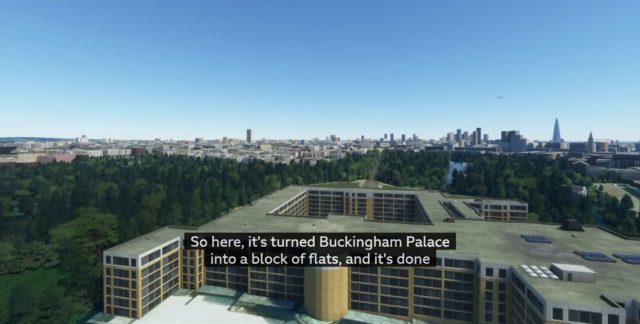
Research scientist and author Janelle Shane, who wrote a book on AI weirdness (called You Look Like A Thing And I Love You), explains how this happened:
Because a nondescript office building is a reasonable default guess given a square building pad and a many-story height, the AI will tend to populate the planet with them unless specifically told otherwise. The Statue of Liberty, the Taj Mahal, and the Eiffel Tower are all lavishly hand-modeled in 3D. But The Motherland Calls statue of Volgograd is a condo high-rise, Buckingham Palace is an apartment complex, the Leaning Tower of Pisa is a vertical concrete silo, and the Pyramid of the Sun is a nondescript warehouse with a hilarious tiny dome on its roof.
More relevant to our interests, the AI also seems to be interested in creating airliners out of brick … or maybe just converting Dunsfold Aerodrome to aircraft-themed housing? Either way, I’m interested!
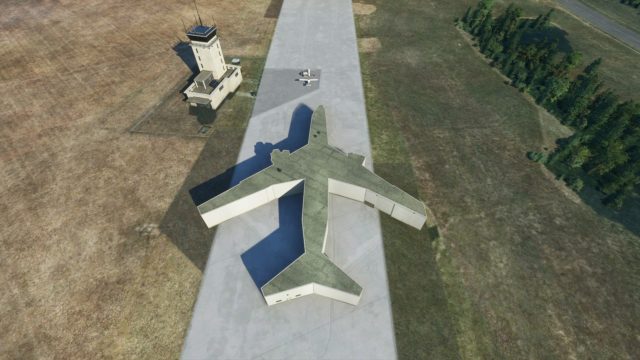
A quick look at Dunsfold Aerodrome gives us a hint as to what went wrong:
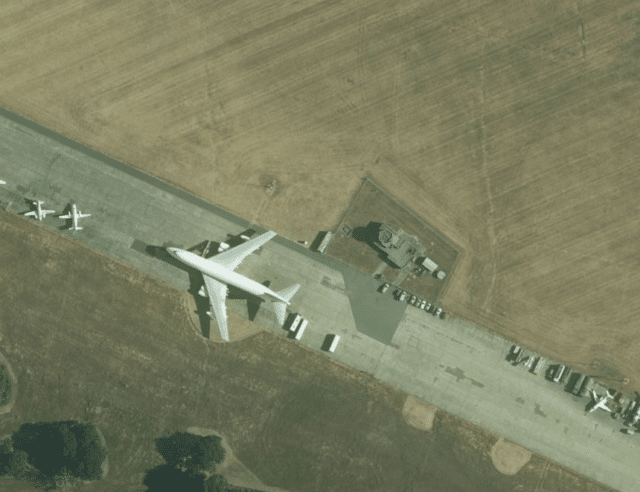
Finally, there’s the long running joke of flight simulator players hoping to be the most qualified person on a flight with an emergency.
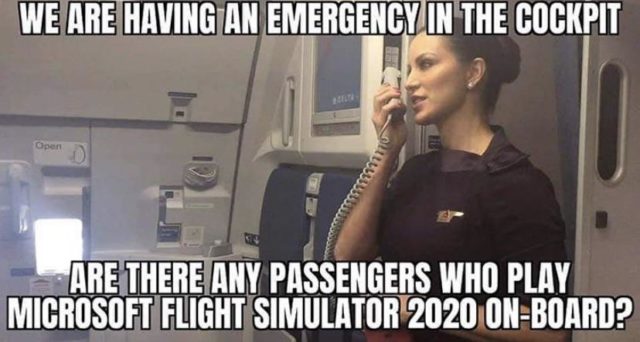
This is such a common theme that I wrote a short story about exactly that which you can read on my Patreon (free, no registration needed): In Command.
However, this video of a landing Microsoft Flight Simulator 2020 shows just why this is unlikely to ever be the case…
Microsoft and Asobo Studios, who developed the simulator and the procedural engine, have been fixing locations and other anomalies as quickly as they’ve been reported.
It has to be said that despite all of this madness, I’ve not heard of anyone asking for a refund.

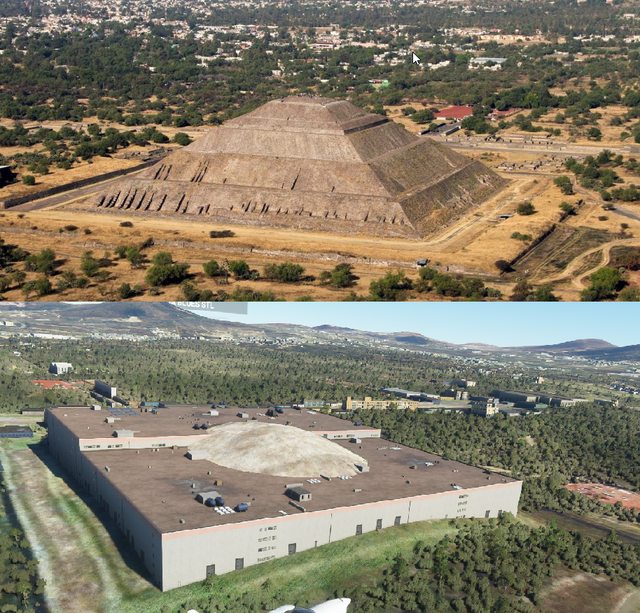







I was one of the guys on a TRS-80 flying Sublogic Flight Simulator in glorious 128×48 pixel resolution.
I can’t even get a display for the Raspberry Pi with that low of a resolution.
I have a copy of Bruce A. Artwick’s “Microcomputer Displays, Graphics, and Animation” subtitled “from the creator of FLIGHT SIMULATOR”
It’s pretty meaty and I learned a lot from it.
I also have Charles Gulick’s “40 Great Flight Simulator Adventures” for Flight Simulator and Flight Simulator II on the Apple, IBM, Commodore 64, and Atari.
It’s “set your position/altitude/heading here, then follow this path to these wonderful wire-frame sights”
“Wonderful wire-frame sights” haha! Perfectly put.
From the Gulick book, “The Mystery of Sammamish” is a flight to the original FS 1 airport, included as an early easter egg.
Another “We Aim to Please” is a flight between (or into) the World Trade Center Twin Towers. In a book with a copyright date of 1985. That didn’t age well.
Here I am showing my age: Out of my depth. For me a computer is a “confuser”. But hey, when I was flying aircraft during the final years of my career they all had computers, especially for the navigation. Some were very basic, the last ones were getting more sophisticated.
Airlines with fixed route systems have their routes pre-programmed. So when flying, for argument’s sake, from Frankfurt to Madrid, all the crew has to do is to call up the route and add the relevant SID.
For corporate operations the situation is a bit more complicated. There are companies that specialise in filing the flight plans. Corporate operators have a contract with them. Necessary because today we don’t fly from VOR-DME to VOR-DME any more, especially not in the upper airspace. All determined by waypoints and the route is determined by computer. And often there are variations in the actual route, depending on the traffic. So the crew will often have to program new routes in the nav system. It is amazing how the younger generation of pilots is getting totally dependent on them. Often we were taxying, doing the pre-departure checklists and my F/O would be busy entering the entire route. Most high-powered business executives do not take kindly to sitting on the tarmac whilst the crew are tapping the coordinates in the computer. Later systems could be programmed using the 5 character identifiers, but even so. Often I was given a reproachful look when I told them just to enter the SID, maybe one or two of the next waypoints and the destination. More than enough time to enter the rest in the air.
Another form of computer system, more relevant to today’s blog, is the simulator. The computer graphics have made gigantic leaps.
The first ones did not even move much more, the original “Link” could not do much more than wobble and turn to give the feeling of movement. The instructor had a table with a perspex top. A map of the desired area would be positioned and a “crab” traced the route that the aircraft – if it had been one – would have followed in ink. The beacons could be programmed, even before the advent of computer systems.
The trainee pilot had no visibility at all. I did a lot of basic training in a Frasca simulator, a bit more advanced but it had no motion at all.
Later again the instructor could, at the push of a button, conjure up an image of approach lights on the otherwise opaque windscreen.
Later again the final stages of the approach could be made visible by a sort of video in front of the simulator. For vision, the first Concorde simulator made use of a miniature camera mounted on a bar across a large mock-up of an airport and the surrounding area. To prevent a sudden cut-off the edges were mirrored. The camera would track over the mock-up and the result was projected on screens in front of the windscreen. One session the crew had to break-off the lading because of a monster on the runway: a fly had settled there and was projected in enlarged form. The whole thing was large. Mounted on its side it did not take too much space. I have seen it in the factory, later it was in the museum at Le Bourget.
Most of the earlier type dedicated simulators that I trained in had simulated vision of the airports in the memory, at night only. So most of the lights at the airport, taxyways, runways and the surrounding area. Reasonably realistic. On once session we flew the Citation under Brooklyn Bridge. The processing power increased. Initially, the airports in colour vision were impressive but once airborne the landscape became featureless. Just large coloured rectangles. Nowadays it is nearly photographic, even the side screens have vision.
When I worked with Digital Equipment some experts developed a computer game based on various aircraft types. The first images were looking as if they were made of bits of wire, but gradually they became more accurate. The company had manufacturing bases world-wide. Different programmers worked and played with it. Sometimes we could be confronted with an aircraft taking off from the opposite end of our runway. A guy a few thousand miles away might be using the same set-up. Once we flew a 747 through the large fountain in Geneva.This was in the ‘eighties. Digital was a leader in networking, even before the world-wide web.
But a passenger flying an approach in a large modern jet aircraft to a successful landing, based on experience with a home computer? Very doubtful in my opinion.
Rudy, just to bring it full circle, the first flight simulator (that Artwick did for his thesis) was on a DEC machine. :)
Sylvia, yes I remember now that you reminded me. Many professional flight simulators, the ones with full motion and computer generated vision, were powered by DEC computers. The UK government also bought them for the air traffic control centres. I remember that there were discussions in DEC. Some senior people in the company were afraid of the consequences, should a computer failure lead to a serious accident. This could have led to potentially damaging law suits and compensation claims. That, together with the loss of faith in the products, was something that was the subject of serious debates. The company had cash reserves in the order of several billion. That was a “deep pocket”. Today, with Jeff Bezos personally making some sixty billion $$$ in the first half of 2020 alone, a few billion is a paltry sum of money, but it was serious moolah back in 1986.
That Microsoft landing looked just fine.
As long as all the passengers were properly belted in!
Well, I just re-read an old blog of Sylvia in which she describes her introduction to the Citation Sovereign simulator of Flight Safety International at Farnborough.
Sylvia was an experienced private pilot, but she gave a hilariously funny account of her efforts to control the “aircraft”.
Now imagine a passenger trying to bring a real airliner to a safe landing at an airport. And remember, this is supposed to be a real situation, not a simulator he or she can walk away from, either exhilarated or humiliated.
But the – fortunately fictitious – situation is for real. And therefore the volunteer who, with perhaps a bare minimum of flying experience, will be extremely tense and nervous. Not a good frame of mind when the life of the would-be pilot and perhaps a few hundred passengers and cabin crew members depend on a cool head.
In a jet aircraft the problems can accumulate very rapidly and accident reports bear witness to the fact that even professional pilots can become overloaded, their brain no longer able to cope.
No everyone has the brains and nerve of a test pilot, or a Captain Sullenberger. If they did, they would probably be airline captains or even astronauts themselves. No, we are talking about ordinary Joe (or Josephine) Bloggs, suddenly catapulted into the pilot’s seat in the cockpit of a real aircraft, IN THE AIR !
My guess is that they would need an awful of of good luck to pull it off.
But if it ever were to happen, of course I wish them ALL that luck, even more if it were available to them at the right moment.